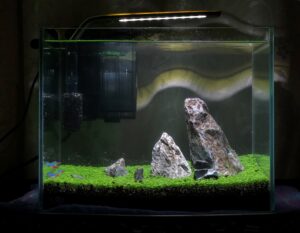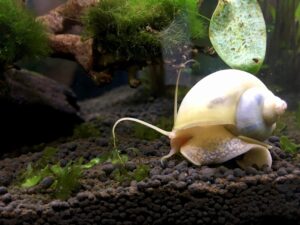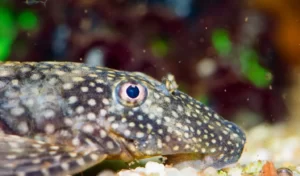
Nerite Snail Care: Tank Mates, Breeding & More

Writer at The Aquarium Keeper
Aquariums are mesmerizing, soothing, and calming. The sight of colorful fish swimming in clear water can reduce stress levels and bring joy to people of all ages. So, if you want to add some color and life to your freshwater aquarium, look no further than the nerite snail. These beautiful and fascinating creatures are known for their unique shell patterns and are popular among aquarium enthusiasts.
This guide will explore everything you need to know about nerite snail care, from tank conditions to feeding, breeding, and maintenance. So, let’s dive in and discover the wonder of these fascinating aquatic creatures!
Nerite Snail Appearance
Nerite snails are beloved for their unique and eye-catching appearance. They are both durable and delicate, with a hard, spiral shell and a soft, squishy body. Nerite snail shells come in various colors and patterns, from black and white stripes to intricate swirls and patterns.

Some types of nerite snails even feature bright, bold colors that make them stand out in any aquarium. As they move around the tank, their shell glints in the light, creating a mesmerizing effect. Overall, nerite snails are a true wonder of nature, and their appearance will surely delight and captivate anyone who admires them. There are over 10 different nerite snail types to choose from, so be sure to find the one that you would like the most.
Nerite Snail Behaviour
Nerite snails are peaceful and fascinating creatures that move slowly and gracefully around the aquarium. They are avid algae-eaters and spend their time grazing on the surfaces of rocks and plants, keeping the tank clean and healthy. These peaceful creatures are non-aggressive and greatly add to any community tank.
Most of the time nerite snails rarely interact with other aquatic creatures, since they like to keep everything to themselves. Nerites can usually be found on aquatic leaves, driftwood, and even falling off these aquatic decorations. These species can sometimes make anyone laugh with their clumsiness.
Nerite Snail Diet
With their herbivorous diet, Nerite snails play an important role in controlling algae growth in the tank, making them a valuable addition to any aquatic ecosystem. These species will spend most of their time cleaning any surface, using their rasping tongue, known as a radula, to scrape off any unwanted algae. They will feast on almost any algae type, including soft algae, green spot algae, green dust algae, hair algae, brown algae, and even black beard algae.
However, if there aren’t enough algae in the tank to sustain them, nerite snails can also be fed various foods, such as sinking pellets or blanched vegetables. But, they can be a bit fussy regarding supplemental food, so it may take some time for them to get used to it. One thing to remember is that nerite snails eat a lot, and, as with any snail, they will contribute to the tank’s bioload. So regular water changes and maintenance are necessary to keep the tank healthy.
Nerite Snail Care
Nerite snails are fascinating species that can add character and beauty to any aquarium. These snails are pleasing to the eye and have a significant role in maintaining the ecosystem of the tank. That’s why proper care is essential to ensure they thrive in their environment and perform their duties efficiently. However, with just a few guidelines and attention to detail, anyone can provide a suitable environment for nerite snails.
Tank Size
The tank size is one of the essential factors to consider when caring for nerite snails. While these snails are relatively small, they need enough space to move around, forage, and explore their environment. Therefore, keeping a nerite snail in a tank with a minimum size of 10 gallons is recommended. However, a larger tank will be necessary if you plan to keep multiple nerite snails or other aquatic creatures in the same tank.
Having enough space also helps to maintain stable water parameters and prevents the buildup of harmful toxins. In a smaller tank, it can be challenging to maintain water quality, leading to stress and potential health issues for your snails. Therefore, investing in a larger tank for your nerite snails will provide a healthier environment for them and create a more visually appealing aquatic display in your home.
Tank Setup
Creating a proper tank setup for your nerite snails is crucial to their health and well-being. So, when decorating your tank, here are a few things to consider:
- Ensure the aquarium has plenty of hiding places, such as rocks, driftwood, or plants, to give your snails a sense of security. A well-decorated tank also helps simulate their natural habitat and encourages natural behavior.
- Ensure the aquarium has a proper filtration system to maintain water quality and stability. Keeping the water conditions stable is essential to prevent unnecessary stress and disease. If you are planning on having a 10-gallon aquarium, aim to have a filter, that filtrates at least 20 gallons per hour. A good rule is to have 2x the water amount of filtration in your tank.
- Consider adding a light source to the tank to promote healthy algae growth, the primary food source for Nerite snails. These species don’t really care about light intensity, so be sure to pick the best lighting options that fit your needs.
- Having an air pump to keep the water aerated is also a crucial part of the nerite snail care. These species breathe through their gills and need aerated water to do that. An air pump is a great way to keep the water moving, introducing oxygen at the same time.
- The most important thing to remember when caring for nerite snails is their sensitivity to copper. Copper is often found in tap water and can harm these delicate creatures. Therefore, it’s best to use a water conditioner that removes any traces of copper before adding it to the tank. You can also purchase an aquarium water test kit to check copper levels in your tank water.
Water Parameters
Nerite snails are highly sensitive to changes in their environment, and any fluctuations in the water parameters can lead to the development of cracks in their shells and even death. Dead snails in a fish tank can cause numerous problems, so keeping good water parameters to prevent this from happening should be a priority.
Nerite snails prefer well-oxygenated warm waters with low TDS in their natural habitat. That is why it’s essential to maintain specific water parameters in your aquarium to ensure the health and longevity of your snails. To create an optimal environment for nerite snails, you must maintain a temperature range of 20–26 °C (60–79 °F), a pH range of 6.0 – 8.0, and a TDS range of 60 – 200 PPM.
It’s important to note that nerite snails require a higher pH level than most other aquarium species, which can make finding suitable tank mates challenging. However, maintaining a pH level of around 7.5 or slightly lower is a suitable habitat for your nerite snails. Remember, keeping your aquarium water parameters stable and not making any sudden changes is crucial to nerite snail well-being.
Nerite Snail Diseases & Prevention
Although nerite snails are hardy creatures, they are still susceptible to various diseases. However, by taking the necessary precautions and understanding the common diseases in time, you can prevent these issues and keep your snails healthy and happy. Most of the time it is hard to diagnose a problem with a snail since we only see the outside of the shell.
One common issue that affects nerite snails is fungal infections. These infections usually occur in the gills, causing them to close and preventing the snail from breathing. To prevent this, ensure that the water in your tank is properly aerated and has a stable pH level.
Another common issue is parasitic infections, such as anchor worms and flukes. These can be prevented by properly quarantining any new plants or animals added to your tank and regularly cleaning your aquarium.
Nerite snails are also susceptible to shell erosion and cracking. It can be caused by poor water quality or a lack of calcium in their diet. To prevent this, ensure your tank has stable and clean water parameters and feed your snails a balanced diet. You can also add calcium supplements to your aquarium to ensure the longevity of your nerite snail shell.
Nerite Snail Tank Mates
Nerite snails are the “peacekeepers” of the aquarium world, bringing tranquility and harmony to any tank they call home. Small schooling fish like neon tetras, chili rasboras, and celestial pearl danios are excellent nerite snail tank mates. Other invertebrates like neocaridina shrimp and rabbit snails are also viable options.
However, while nerite snails are non-aggressive and kind-hearted creatures, they need protection from the aquarium’s “big bad bullies.” Therefore, I do not recommend keeping nerite snails with species like pufferfish, cichlids, and other larger aquatic fish.
Nerite Snail Lifespan
The lifespan of a Nerite snail can vary depending on various factors, such as water quality, diet, and tank size. The average lifespan of nerite snails is around 1 to 2 years. However, their lifespan can be extended with proper care and a suitable environment.
In fact, there are instances where fellow fish keepers kept the same nerite snail for over a decade! For example, in this post, a nerite snail owner shares their experience about keeping the same nerite snail for 11 years! This could have only been achieved with proper care and good conditions.
Nerite Snail Breeding
Nerite snails are known for leaving a bunch of white little eggs all around the aquarium, including decorations like rocks, driftwood, and sometimes even plants. It is hard to understand what to do with these freshwater snail eggs in our fish tank. Unfortunately, nerite snails most of the time leave these eggs, and they don’t hatch, since they can only develop in proper breeding conditions.
Breeding nerite snails is a unique and fascinating process that requires careful attention and specific details. Unlike other snails, these species do not reproduce asexually. Instead, female nerite snails lay eggs that males then fertilize. However, for these eggs to hatch, the larvae require brackish water to survive. The temperature and other water conditions should be the same as mentioned before.

To successfully breed nerite snails, you must move the eggs to a tank with brackish water or try to breed nerite snails, that live in brackish water. Also, it is essential to have an even ratio of males to females in the breeding tank and enough space for each snail to thrive.
It’s important to note that forcing nerite snails to breed is difficult, so patience is key. However, providing the best possible environment, including ample space and good water quality, can increase the likelihood of successful breeding. Breeding nerite snails can be a rewarding experience for those who are willing to put in the time and effort.
Frequently Asked Questions
Do Nerite Snails Crossbreed?
No, Nerite snails cannot crossbreed with other snail species. For example, you could only breed zebra nerites with the same species. All nerite snail types are slightly different and come from various regions, which means they can only breed with their own kind.
Do Nerite Snails Require Calcium Supplements?
Nerite snails don’t need constant calcium supplements. If you see any damage on the snail shell, it can indicate, that the snail does not absorb enough calcium. That would be a good time to add some calcium supplements to your aquarium.
Writer's Thoughts
In conclusion, if you’re looking for a low-maintenance and charming addition to your aquarium, nerite snails are the way to go! With their vibrant colors, intricate patterns, and quirky personalities, they are sure to bring joy to your underwater world.
By providing them with the proper tank size, setup, water parameters, and a healthy diet, you can ensure they will live long and happy lives. And with some care, attention, and love, you’ll enjoy watching these little snails thrive and explore their aquatic paradise. So go ahead and add some nerite snails to your aquarium today – you won’t regret it!
If you enjoyed reading this article, please feel free to share it with your friends by clicking the social media buttons below:





